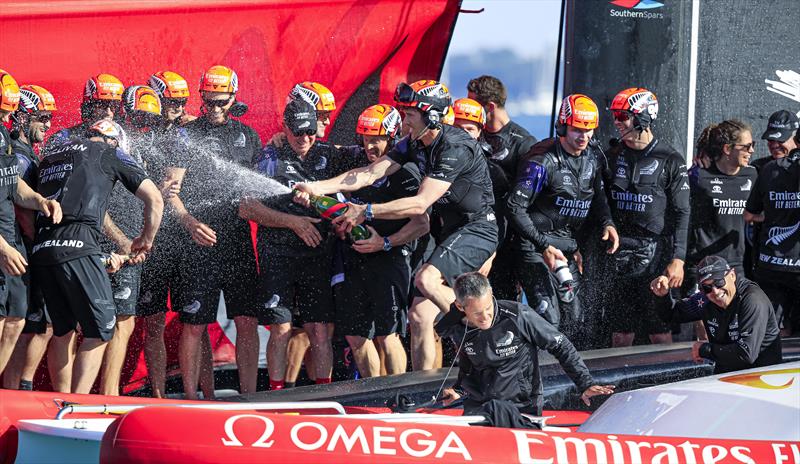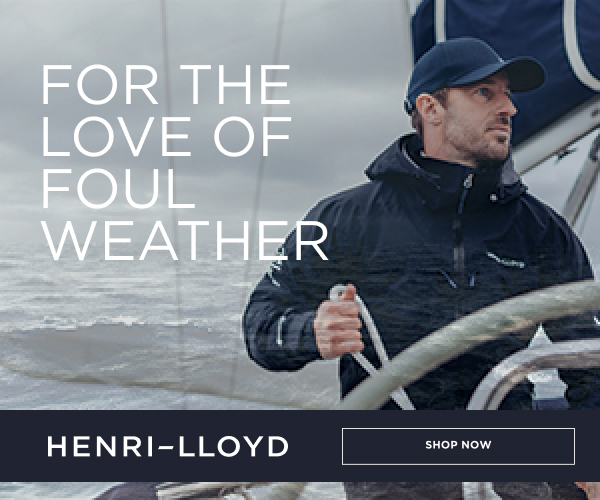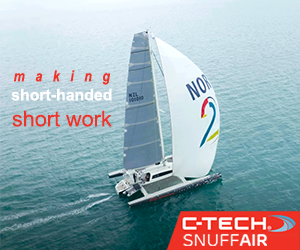Burling and Tuke make sailing history in a challenging year
by Richard Gladwell/Sail-World.com/nz 29 Nov 14:47 PST

Skipper Peter Burling gives the Emirates Team NZ crew a victory spray just after the final race in the 36th America’s Cup. © ACE / Studio Borlenghi
For Rolex World Sailor of the Year nominees Peter Burling and Blair Tuke, 2021 was always going to be a challenging year to manage.
“It has been an awesome 12 months for Pete and me,” Blair Tuke told Sail-World. “We were part of the team that defended the America’s Cup on the Hauraki Gulf and followed that with our final preparation for the Olympic Games. Winning a Silver medal was awesome at Tokyo2020, and then we stayed overseas for the European legs of the SailGP.”
Peter Burling was skipper, and Blair Tuke was flight controller aboard Emirates Team New Zealand’s Te Rehutai. They were part of the 120 strong professional sailing team based in Auckland. The 2021 Cup win was the team’s fourth in 35 years of competition.
“After the America’s Cup win, we jumped into the 49er and gave it a huge push for four months,” Burling recalled.
“Tokyo2020 was the strangest Olympic Games I have attended. No crowds and a completely different build-up to normal. For us, there were no competition events in the 49er for 18 months before the Olympic regatta.”
“This year was always going to be a hell of a challenge – even more so when the schedule changed, putting the Olympics and America’s Cup within four months of each other. Even though it wasn’t our best performance on the water, we were still incredibly proud to win another Olympic medal for our country.”
A tie break decided the Olympic Gold and Silver medals in the 49er after the British crew picked up a vital win in the closest finish at Enoshima. The Kiwis and Brits scored equal points, with Dylan Fletcher and Stuart Bithell, who nabbed a crucial Medal race win, and the Gold medal in a split-second finish.
“The Medal Race was a roller coaster,” Burling said. “But Blair and I made sure we went into the race with a shot at medaling.
“We didn’t get off to the best start in the regatta but we fought our way back leading a tight group into the Medal race. After choosing the wrong side on the first beat we bounced back and at the last top mark found ourselves right on the heels of the GB team. With the Germans in the lead we were doing enough for Gold. The British managed to pip the Germans for the race on the line meaning we slipped back to the silver medal position.”
America’s Cup
Attempting to successfully defend both the America’s Cup and an Olympic title in the same year is without precedent – let alone when the two events are just four months apart.
As Olympic Silver medalists, Peter Burling and Blair Tuke created sailing history by being the first sailors to win Olympic and America’s Cup medals in the same year.
Both the America’s Cup and Tokyo2020 were pressure contests, where the Kiwis lacked pre-series competition.
Covid forced the cancellation of both America’s Cup World Series regattas scheduled for Europe in April and June 2020. All four “super teams” raced against each other for the first time in mid-December, where Burling skippered the America’s Cup defender to a last leg, series-winning race, in the final of the America’s Cup World Series.
That set the scene for rapid development process between the three Challengers. American Magic emerged as top challenger from the ACWS. Then it was a rejuvenated INEOS Team UK that confounded the pundits winning the Round Robin phase of the Prada Cup, and then an upgraded Luna Rossa, won the final and the right to challenge for the America’s Cup. The Italians stepped up their game yet again – winning more America’s Cup Match races, than any challenger in history, without winning the most prestigious trophy in sailing.
Three days into the 36th Match, Emirates Team New Zealand had a fight on their hands with the Defender and Challenger sitting on three wins apiece. Surprisingly there had been no lead changes in the first six races.
The Italians admitted they had been working hard to keep their emotions under control after race wins – and clear heads were prevailing. With co-helmsmen Jimmy Spithill and Francesco Bruni sharing the helming, questions were being asked of the Kiwis. Spithill the long-time nemesis of Emirates Team New Zealand, smelt kiwi blood and started playing up the advantages of their unorthodox helming set-up.
Speculation was rife around the Auckland waterfront as to what happened back at the team base that night. Was there a “Come to Jesus” session for the Kiwi afterguard who were believed pre-series to have the fastest boat? Or was it a table-thumping session in the All Black tradition?
“Neither,” says Blair Tuke. “It was just a standard debrief. We always have solid debriefs and try to improve. It was a tough challenge going up against a battle-hardened Luna Rossa when we’d had limited time in tight racing situations.”
“It wasn’t just that night (Day 3) the same level of debriefs had been going on for the other two nights. We were pretty happy about the learning curve.”
“When we came out the next day, we were able to make that critical overtake in Race 7 and then built momentum to finish the series strong.”
“We put a lot of work into getting a structure in place to enable us to learn and develop throughout the series,” Tuke continued.
Emirates Team New Zealand skipper Peter Burling says race 9 on Course C, the Stadium
Course was their most dramatic race of the 36th Match.
“There were about 10 different lead changes. Everyone makes a big deal about how there were no lead changes early on in the America’s Cup, but those first three days were the hardest conditions in which to have a lead change. The winds were incredibly steady and anyone who has watched an AC75 will be aware that they kick up a massive wind shadow. So if you are following it is pretty hard to keep close contact with the boat ahead and find a passing lane.”
“We knew the turbulence was there, but didn’t quite realise the extent of it – especially in the lighter end of the wind range.”
“In stronger winds, the wind shadow is slightly less, creating more lead change opportunities.”
SailGP
Five weeks after the successful America’s Cup defence, Peter and Blair were in Bermuda, scene of the 2017 America’s Cup win, racing in their first SailGP event.
Conceived by five-times America’s Cup winner, Russell Coutts and backed by software mogul, Larry Ellison, the SailGP league consists of eight national teams, sailing one-design wingsailed foiling catamarans, with six crew, derived from the AC50 class sailed in the 2017 America’s Cup.
Now in just its second season, the SailGP league sails an eight regatta, eight-country circuit over a 12 month period.
Sailing a new boat, which was only completed and commissioned in Bermuda, Burling says “we didn’t get a bad result, everything considered. The fact is that we only launched the boat the day before the regatta and were having quite a few issues with it. As we have got a lot better as a team, it has felt like we have got more unlucky with the end results – just missing the podium race in those last two events.”
“SailGP is a top fleet of the best sailors in the world, sailing high performance one-design boats,” Blair Tuke explains. “We are very proud of the learning that we have done, over the whole season.
“We are still quite short on time compared to the other teams. A lot of them have already had their first season or had sailed boats in a similar configuration to the F50.”
“From the start in Bermuda there has been a continued learning which we have been really happy with, but there have also been a couple of disappointments.”
“But it is the overall growth of the team that has been awesome,” says Tuke, who clearly views their SailGP program as a work in progress.
“Seeing the boat racing in Europe with Live Ocean on the sail and with the blue fern has been awesome,” he adds. “From a performance point of view that race win in Cadiz in challenging conditions was our highlight. Sailed very top end conditions, we got out early that day, had a good training session, and won the first race.”
“I think we would have liked a slightly better result in Cadiz to keep us closer to that final podium race,” says Burling. “With SailGP you only need to get in the top three to be able to win the Season in that last race. For us, the goal has always been to make the top three in San Francisco. That will be hard from where we currently are, but not impossible.
“We just have to go into the last two regattas putting our best foot forward and trying to get a good result on the board.”
With the next America’s Cup not until 2024, and with Paris2024 set down for the same timeframe. Burling and Tuke’s immediate focus for the next 12 months, will be on developing the SailGP team and expanding their conservation foundation, Live Ocean.
“We’re definitely going to keep building and growing,” Burling says.
“SailGP is a multi-faceted event, offering a lot of opportunities.”
“We are working very hard to bring an event to New Zealand, and that has been a really cool part of the journey.”
Live Ocean
“We want to see NZSailGP,” as their team is known, “grow and build to represent Aotearoa, alongside giving some meaning as to why we race – which is the connection to Live Ocean.”
“Everyone is really buying into our mission and getting on board, and want to see some positive change for our oceans as well.”
“For us, Live Ocean is a massive passion. When we first started chatting to Russell about getting involved and running the New Zealand SailGP Team. A big part of that discussion was making sure that we could weave Live Ocean into the program.”
The race to save the Antipodean albatross from Live Ocean on Vimeo.
“Now all SailGP teams have to have a charity partner, and we also race for the Impact League. Being able to use sport as a platform to raise awareness about ocean-based issues, and the sport of sailing on the ocean, for us is an amazingly powerful tool,” Tuke says.
The SailGP Impact League tracks the positive actions teams make to reduce their overall carbon footprint and help accelerate inclusivity in sailing. Each team is audited and scored after each event. Currently NZSailGP top the Impact league leaderboard with two events left.
“When we came into this we wanted to do more than just sail boats and win races, we wanted to have a positive input into the ocean, and use our profiles and platforms that we have through sport to connect people and reach people who would otherwise be unaware of these issues.”
“Live Ocean is still very young, but it has been a good couple of years and it is now a substantial organisation employing five people,” he added.
“One of the real drivers with Live Ocean is getting people to care about the ocean and what it really does for us and keeps us alive,” Burling says. “It produces every second breath of oxygen, it absorbs 90% of the heat, it absorbs the same amount of CO2 as the land. For us we need to get these amazing projects going so that we can tell these really cool stories as well.”
“We are a conduit organisation,” Tuke explains. “So we partner with promising scientists, innovators and communicators. We have a great group of advisers who help assess which work to support. We are trying to amplify and accelerate, tell stories, and make things happen more quickly.”
Live Ocean’s current projects include ongoing work to highlight the plight of the Antipodean Albatross- a project launched two years ago. “As you saw in Cadiz there is an agreement in the making between the Spanish and New Zealand governments over southern ocean conservation, boosting protections for threatened seabirds including albatross and petrels. Many of the issues are actually in the Pacific Ocean where albatrosses come north out of the Southern Ocean up into where they cross over with fishing fleets. It covers the Pacific Ocean, even the Tasman and right around New Zealand.”
“We will do another year of support for some really excellent research into the Southern Right Whale . We are seeing a really good story with the whales bouncing back from whaling times; their population is ever-increasing with their wintering grounds around the Auckland Islands. But the whales are facing a new challenge with a changing ocean, we have to understand where the whales are going for food and how that is changing with a rapidly changing climate.”
“Then there is some really cool work going on around the Hauraki Gulf looking at kelp restoration, specifically areas of the Gulf that have been decimated by kina (sea urchins) – that is a really good project with some great results showing.
“Live Ocean has partnered with New Zealand Geographic on a project called Seascape, ” Burling explains. “It involves being able to measure changes in the seascape through photogrammetry [a three-dimensional coordinate measuring technique that uses photographs as the fundamental medium] of areas and being able to monitor change over a period of time.”
“That is something that has been a challenge for the ocean, is out of sight and out of mind in a lot of ways. When you go below the surface, you can see if it is healthy or unhealthy and unless you do that over a period of time, it is very hard to tell the difference. It has been a pretty incredible journey.
“Both of us would say we only knew a little of what the ocean does for us, before we started Live Ocean. The more we get into it, the more passionate we become about protecting it.”
“Live Ocean is also working with Te Toki Voyaging Trust who use waka and voyaging as a way of connecting young people to their ancestors and traditional knowledge like celestial navigation. At the same time they’re tuning into the ocean and the life in it. Pete and I’ve been really enjoying the learning here” says Tuke.
To vote in the Rolex Sailor of the Year click here




